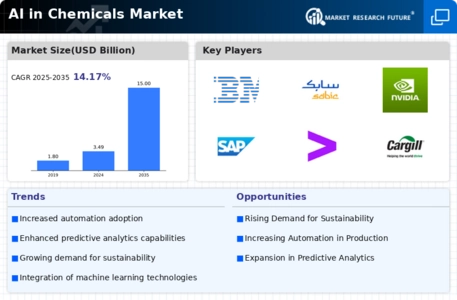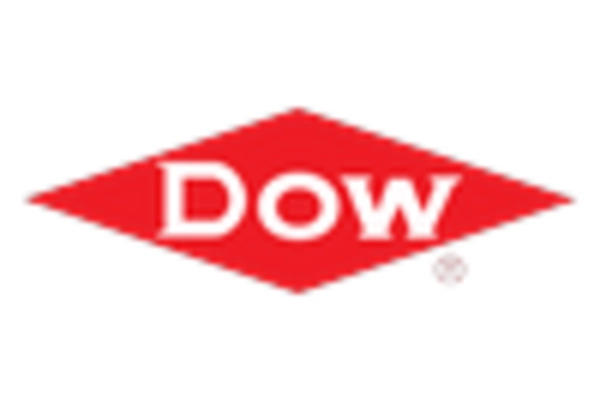Focus on Sustainable Practices
The AI in Chemicals Market is increasingly focusing on sustainable practices, driven by both consumer demand and regulatory pressures. Companies are leveraging AI to develop greener processes and products, which is becoming a critical factor in maintaining market relevance. AI can assist in identifying sustainable raw materials and optimizing production methods to minimize environmental impact. For example, AI algorithms can analyze lifecycle assessments to determine the most eco-friendly options available. As sustainability becomes a core component of business strategy, firms that effectively utilize AI to enhance their environmental performance are likely to attract more customers and investors. This focus on sustainability not only aligns with The AI in Chemicals Market that is progressively prioritizing eco-conscious practices.
Increased Demand for Efficiency
The AI in Chemicals Market is experiencing a surge in demand for enhanced operational efficiency. Companies are increasingly adopting AI technologies to streamline processes, reduce waste, and optimize resource allocation. According to recent data, the integration of AI can lead to a 20% reduction in operational costs, which is particularly appealing in a sector where margins can be tight. This drive towards efficiency is not merely a trend but a necessity as firms seek to remain competitive. The ability to analyze vast datasets in real-time allows for quicker decision-making and improved production schedules, thereby enhancing overall productivity. As the industry evolves, the focus on efficiency is likely to intensify, pushing more companies to invest in AI solutions that promise substantial returns on investment.
Integration of AI with IoT Technologies
The AI in Chemicals Market is being transformed by the integration of artificial intelligence with Internet of Things (IoT) technologies. This convergence allows for the collection and analysis of data from various sensors and devices throughout the production process. By utilizing AI algorithms, companies can gain insights into operational performance, predict equipment failures, and optimize supply chain logistics. The synergy between AI and IoT is particularly beneficial in monitoring real-time data, which can lead to more informed decision-making. As the industry moves towards smart manufacturing, the adoption of AI and IoT is expected to grow, potentially leading to a more interconnected and efficient production environment. This integration is likely to drive innovation and enhance competitiveness in the chemicals sector.
Advancements in Research and Development
The AI in Chemicals Market is witnessing remarkable advancements in research and development, fueled by the capabilities of artificial intelligence. AI technologies enable chemists and researchers to simulate chemical reactions and predict outcomes with unprecedented accuracy. This capability accelerates the development of new materials and compounds, which is crucial in a fast-paced market. For instance, AI-driven platforms can analyze millions of chemical combinations in a fraction of the time it would take traditional methods. This not only shortens the time to market for new products but also reduces costs associated with trial and error in laboratory settings. As R&D becomes increasingly data-driven, the role of AI in facilitating innovation is expected to grow, making it a pivotal driver in the chemicals sector.
Regulatory Compliance and Safety Enhancements
The AI in Chemicals Market is significantly influenced by the need for regulatory compliance and safety enhancements. As regulations become more stringent, companies are turning to AI to ensure adherence to safety standards and environmental regulations. AI systems can monitor processes in real-time, identifying potential hazards and ensuring compliance with safety protocols. This proactive approach not only mitigates risks but also enhances the overall safety of chemical production. Furthermore, the ability to predict and model the environmental impact of chemical processes is becoming increasingly important. Companies that leverage AI for compliance are likely to gain a competitive edge, as they can demonstrate their commitment to safety and sustainability, which is increasingly valued by consumers and stakeholders alike.


















Leave a Comment